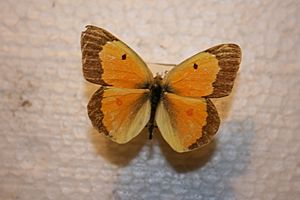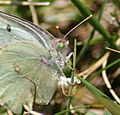Orange sulphur facts for kids
Quick facts for kids Orange sulphur |
|
|---|---|
 |
|
| Dorsal view | |
 |
|
| Ventral view | |
| Conservation status | |
| Scientific classification |
The orange sulphur butterfly is also known as the alfalfa butterfly. When it is a larva (a caterpillar), it is called the alfalfa caterpillar. This butterfly belongs to the family called Pieridae. It is part of the "clouded yellows and sulphurs" group.
You can find the orange sulphur butterfly all over North America. They live from southern Canada down to Mexico. Other butterflies in this group include the common sulphur. These butterflies often mix and create hybrids. This makes it tricky for scientists to figure out their exact family tree.
Orange sulphur caterpillars eat plants from the pea family. They usually feed at night. Sometimes, there are many of these caterpillars. When this happens, they can become a serious pest to alfalfa crops. Farmers can use a special wasp called Cotesia medicaginis to help control these caterpillars. This is a natural way to manage pests.
Contents
Where Do Orange Sulphur Butterflies Live?
Orange sulphur butterflies (C. eurytheme) are found from southern Mexico across most of North America. Long ago, they mostly lived in the western parts of North America. But as people started logging and planting alfalfa fields, these butterflies spread more to the east.
How Do Orange Sulphur Butterflies Look?
Male orange sulphur butterflies have a special pattern on their hindwings. This pattern reflects ultraviolet (UV) light. Female butterflies, however, have wings that absorb UV light.
Scientists have studied these UV-reflecting scales on male wings. They found that special pigments help make the UV light very clear and bright. This helps the male's wings stand out. When a male butterfly flies, its wings move. This makes the UV signal even brighter when seen from above. This bright signal helps males look different from females. It also helps them stand out from the green plants around them.
How Do Orange Sulphur Butterflies Reproduce?
The courtship (mating dance) of the orange sulphur butterfly is quite quick. It does not involve many fancy moves. When a female butterfly is ready to choose a mate, she has a special way to say "no." She uses a specific body pose to refuse males she does not want to mate with. This works for males of her own kind and other species too.
Male butterflies give the female a nutritious packet called a spermatophore when they mate. The female uses the nutrients from this packet to make eggs. She also uses it to keep her body healthy. After she uses up the nutrients, she will look for another mate. In the summer, females might mate every 4 to 6 days. They can mate up to four times in their lifetime.
Images for kids
-
Cloudless sulphur male (left) and orange sulphur male (right)






